C2170 Construction Law: Contracts & Dispute Resolution Report
VerifiedAdded on 2023/04/20
|20
|5380
|306
Report
AI Summary
This report provides a comprehensive overview of construction law, contracts, and dispute resolution, focusing on key aspects such as tender documentation, obligations imposed by law, and potential disputes arising from project execution. It examines issues like staff and equipment removal, staged access, power and IT disruptions, building fire safety, student safety, and asbestos management. The study compares JCT 2011 and 2016 contracts, evaluates advantages of various dispute resolution options, and discusses the importance of proper processes like preliminaries and tender stages in construction projects. The report also addresses challenges related to demolition and construction, equipment disposal, and enabling services and facilities, highlighting the need for effective dispute resolution techniques and adherence to Joint Contracts Tribunal standards to ensure project success.
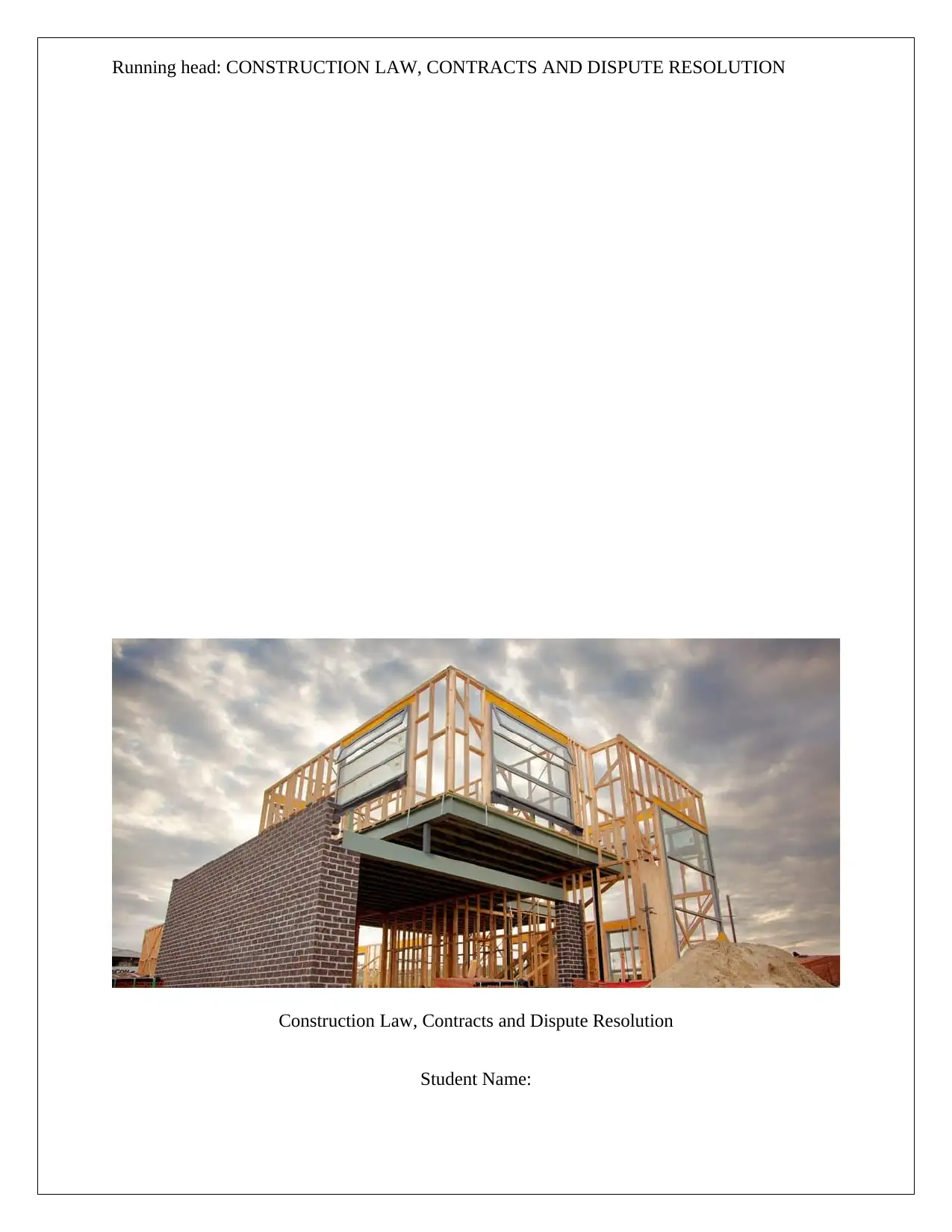
Running head: CONSTRUCTION LAW, CONTRACTS AND DISPUTE RESOLUTION
Construction Law, Contracts and Dispute Resolution
Student Name:
Construction Law, Contracts and Dispute Resolution
Student Name:
Paraphrase This Document
Need a fresh take? Get an instant paraphrase of this document with our AI Paraphraser
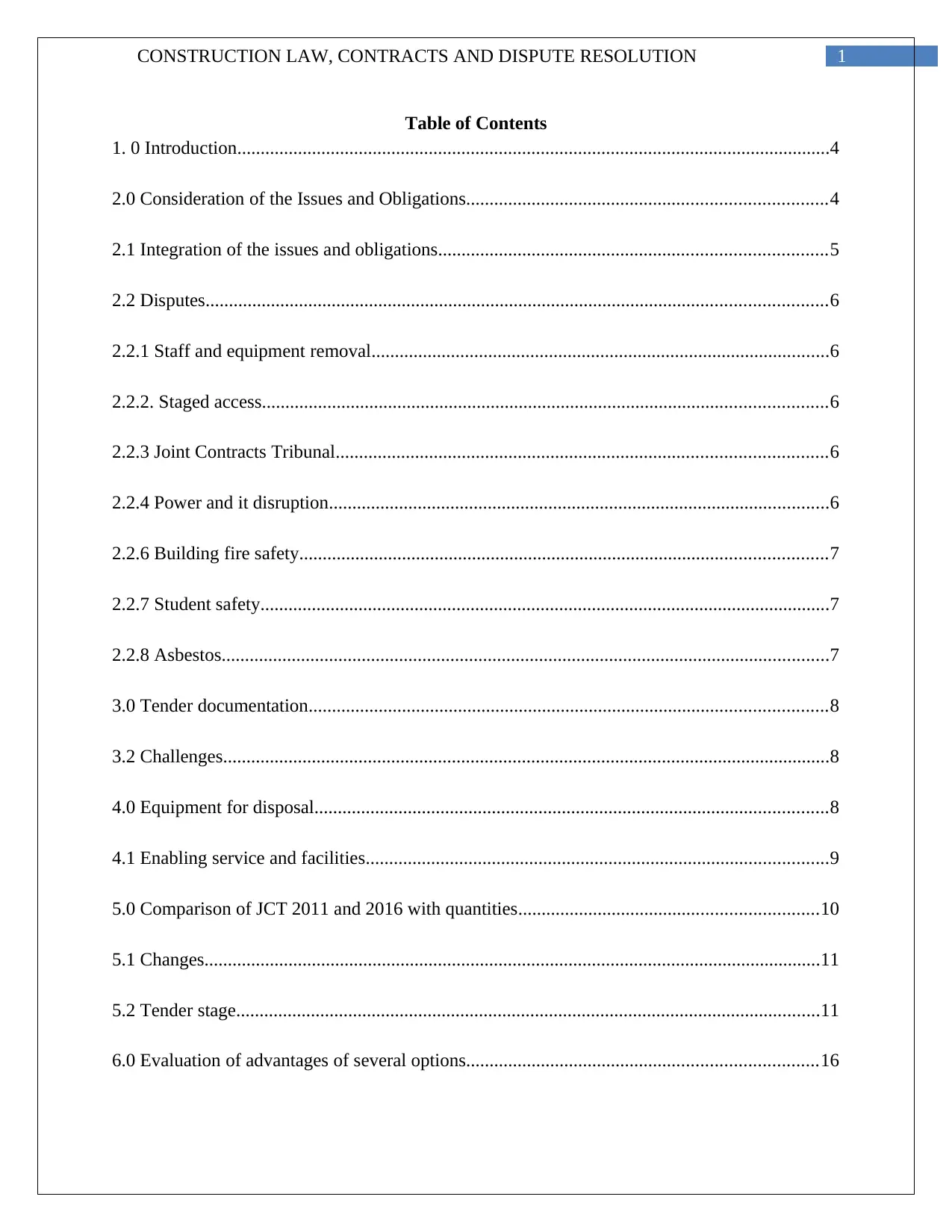
1CONSTRUCTION LAW, CONTRACTS AND DISPUTE RESOLUTION
Table of Contents
1. 0 Introduction...............................................................................................................................4
2.0 Consideration of the Issues and Obligations.............................................................................4
2.1 Integration of the issues and obligations...................................................................................5
2.2 Disputes.....................................................................................................................................6
2.2.1 Staff and equipment removal..................................................................................................6
2.2.2. Staged access.........................................................................................................................6
2.2.3 Joint Contracts Tribunal.........................................................................................................6
2.2.4 Power and it disruption...........................................................................................................6
2.2.6 Building fire safety.................................................................................................................7
2.2.7 Student safety..........................................................................................................................7
2.2.8 Asbestos..................................................................................................................................7
3.0 Tender documentation...............................................................................................................8
3.2 Challenges..................................................................................................................................8
4.0 Equipment for disposal..............................................................................................................8
4.1 Enabling service and facilities...................................................................................................9
5.0 Comparison of JCT 2011 and 2016 with quantities................................................................10
5.1 Changes....................................................................................................................................11
5.2 Tender stage.............................................................................................................................11
6.0 Evaluation of advantages of several options...........................................................................16
Table of Contents
1. 0 Introduction...............................................................................................................................4
2.0 Consideration of the Issues and Obligations.............................................................................4
2.1 Integration of the issues and obligations...................................................................................5
2.2 Disputes.....................................................................................................................................6
2.2.1 Staff and equipment removal..................................................................................................6
2.2.2. Staged access.........................................................................................................................6
2.2.3 Joint Contracts Tribunal.........................................................................................................6
2.2.4 Power and it disruption...........................................................................................................6
2.2.6 Building fire safety.................................................................................................................7
2.2.7 Student safety..........................................................................................................................7
2.2.8 Asbestos..................................................................................................................................7
3.0 Tender documentation...............................................................................................................8
3.2 Challenges..................................................................................................................................8
4.0 Equipment for disposal..............................................................................................................8
4.1 Enabling service and facilities...................................................................................................9
5.0 Comparison of JCT 2011 and 2016 with quantities................................................................10
5.1 Changes....................................................................................................................................11
5.2 Tender stage.............................................................................................................................11
6.0 Evaluation of advantages of several options...........................................................................16
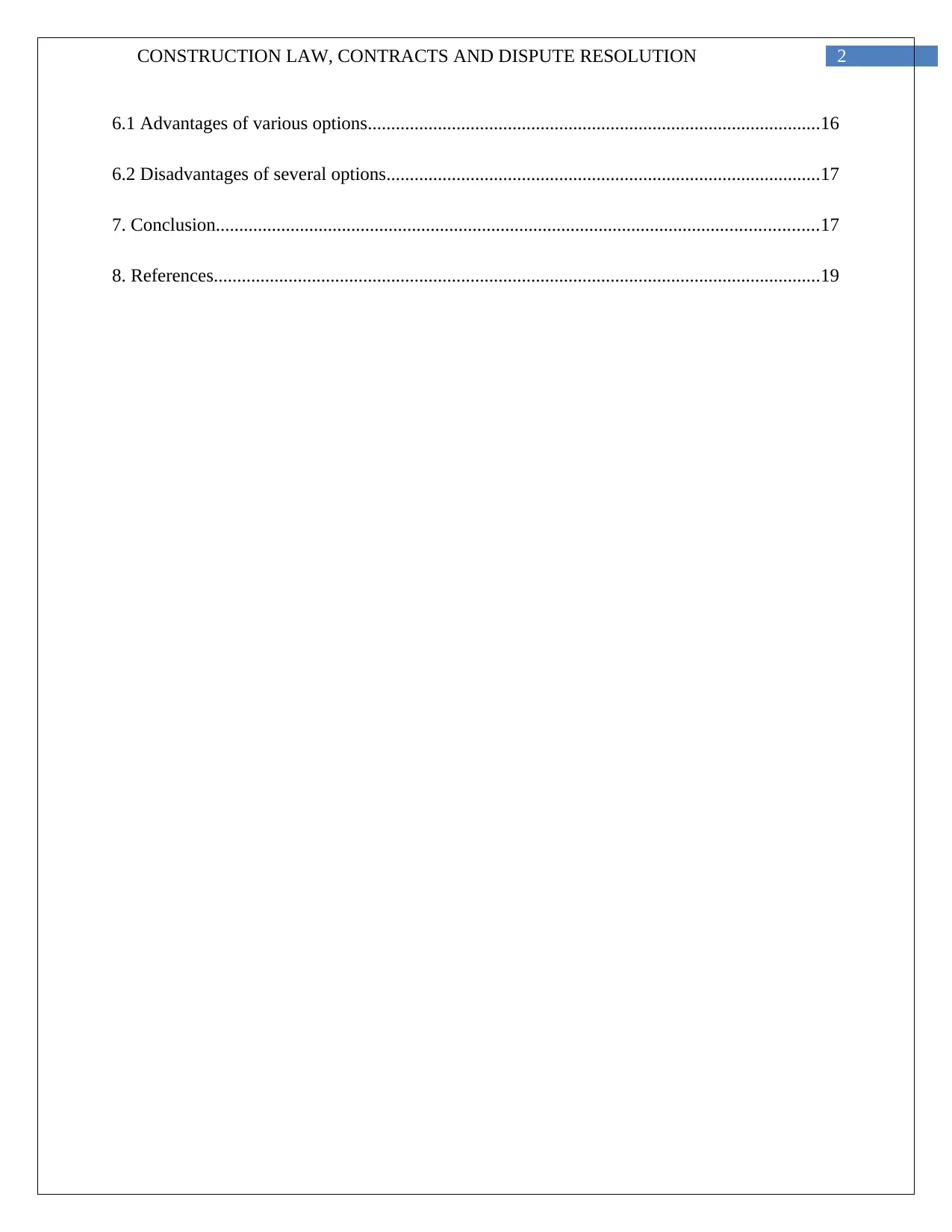
2CONSTRUCTION LAW, CONTRACTS AND DISPUTE RESOLUTION
6.1 Advantages of various options.................................................................................................16
6.2 Disadvantages of several options.............................................................................................17
7. Conclusion.................................................................................................................................17
8. References..................................................................................................................................19
6.1 Advantages of various options.................................................................................................16
6.2 Disadvantages of several options.............................................................................................17
7. Conclusion.................................................................................................................................17
8. References..................................................................................................................................19
⊘ This is a preview!⊘
Do you want full access?
Subscribe today to unlock all pages.

Trusted by 1+ million students worldwide
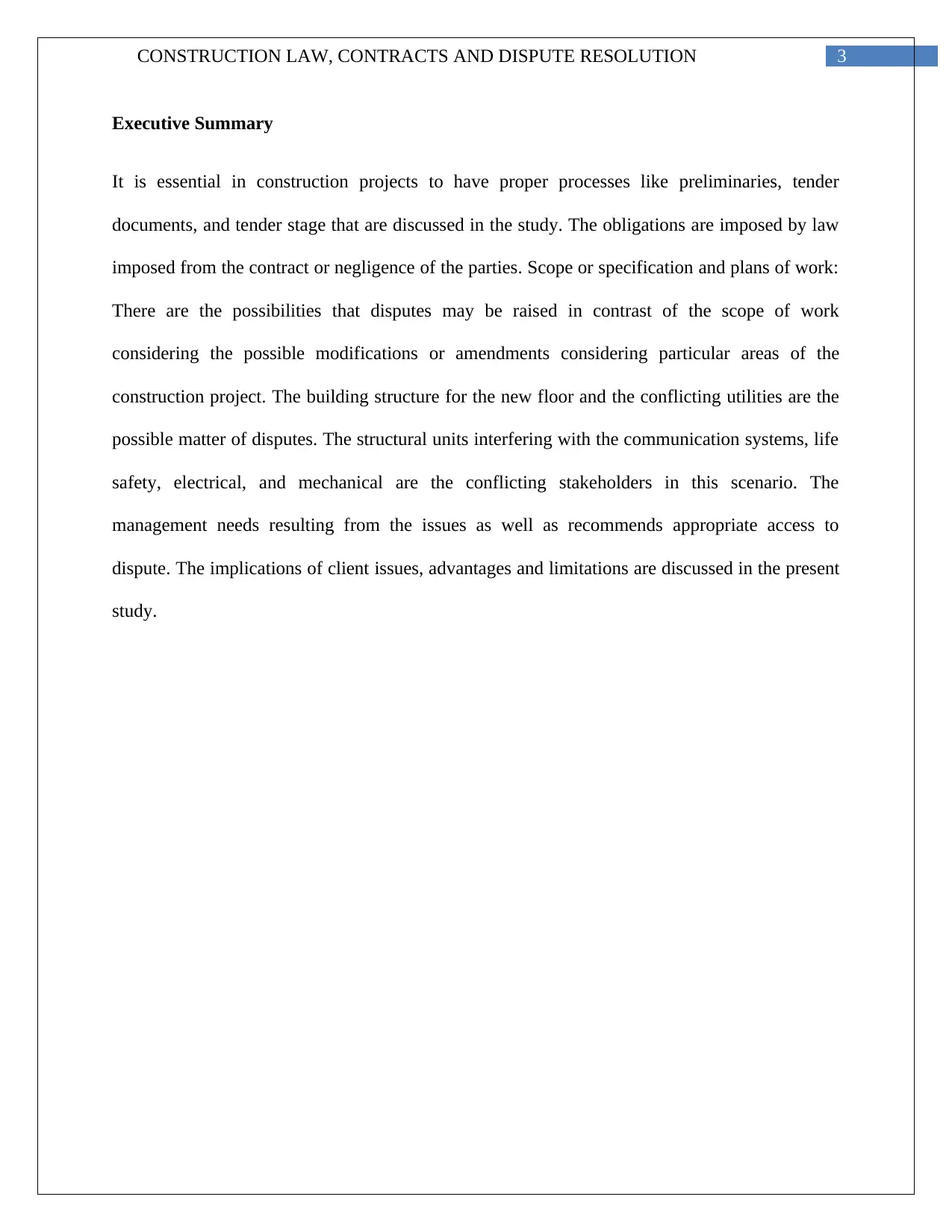
3CONSTRUCTION LAW, CONTRACTS AND DISPUTE RESOLUTION
Executive Summary
It is essential in construction projects to have proper processes like preliminaries, tender
documents, and tender stage that are discussed in the study. The obligations are imposed by law
imposed from the contract or negligence of the parties. Scope or specification and plans of work:
There are the possibilities that disputes may be raised in contrast of the scope of work
considering the possible modifications or amendments considering particular areas of the
construction project. The building structure for the new floor and the conflicting utilities are the
possible matter of disputes. The structural units interfering with the communication systems, life
safety, electrical, and mechanical are the conflicting stakeholders in this scenario. The
management needs resulting from the issues as well as recommends appropriate access to
dispute. The implications of client issues, advantages and limitations are discussed in the present
study.
Executive Summary
It is essential in construction projects to have proper processes like preliminaries, tender
documents, and tender stage that are discussed in the study. The obligations are imposed by law
imposed from the contract or negligence of the parties. Scope or specification and plans of work:
There are the possibilities that disputes may be raised in contrast of the scope of work
considering the possible modifications or amendments considering particular areas of the
construction project. The building structure for the new floor and the conflicting utilities are the
possible matter of disputes. The structural units interfering with the communication systems, life
safety, electrical, and mechanical are the conflicting stakeholders in this scenario. The
management needs resulting from the issues as well as recommends appropriate access to
dispute. The implications of client issues, advantages and limitations are discussed in the present
study.
Paraphrase This Document
Need a fresh take? Get an instant paraphrase of this document with our AI Paraphraser
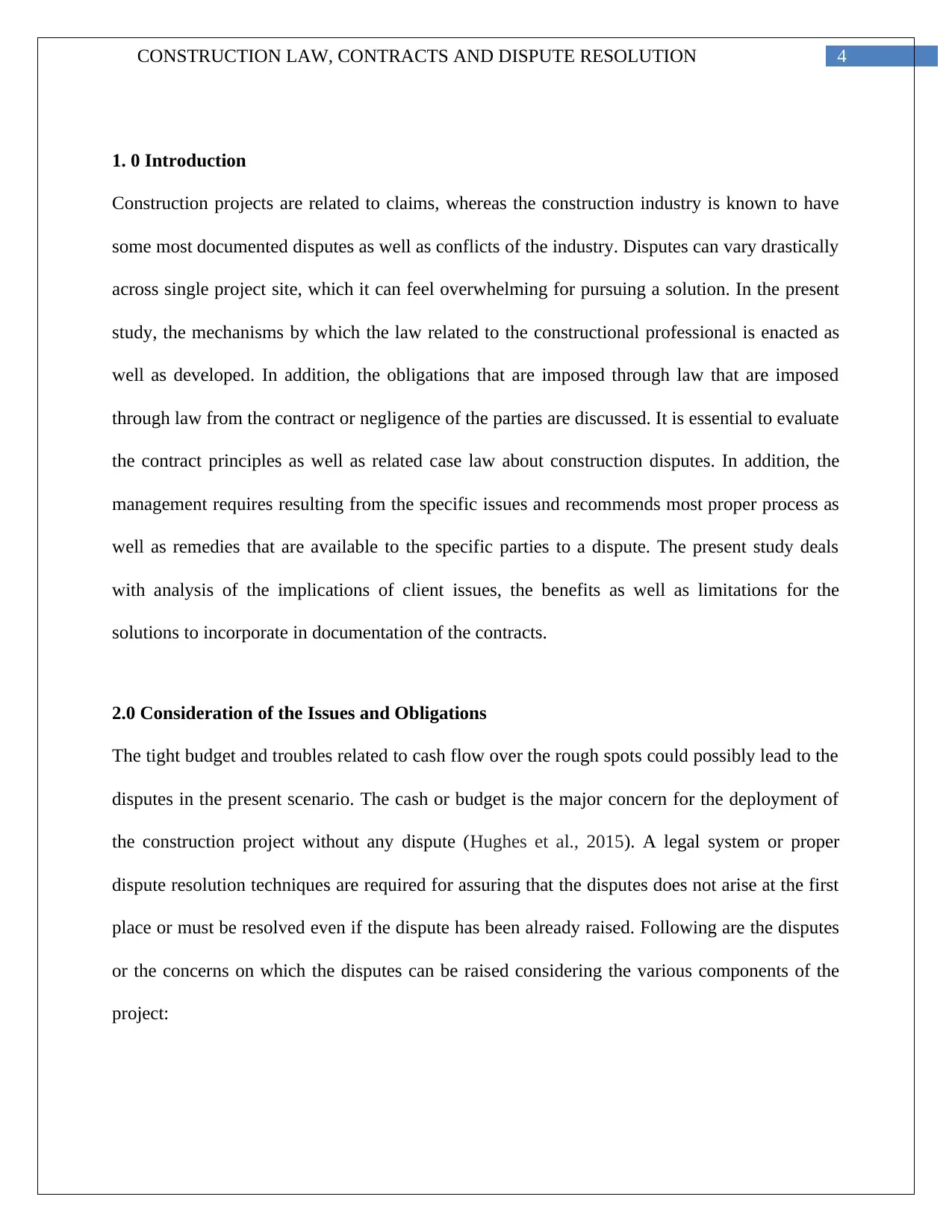
4CONSTRUCTION LAW, CONTRACTS AND DISPUTE RESOLUTION
1. 0 Introduction
Construction projects are related to claims, whereas the construction industry is known to have
some most documented disputes as well as conflicts of the industry. Disputes can vary drastically
across single project site, which it can feel overwhelming for pursuing a solution. In the present
study, the mechanisms by which the law related to the constructional professional is enacted as
well as developed. In addition, the obligations that are imposed through law that are imposed
through law from the contract or negligence of the parties are discussed. It is essential to evaluate
the contract principles as well as related case law about construction disputes. In addition, the
management requires resulting from the specific issues and recommends most proper process as
well as remedies that are available to the specific parties to a dispute. The present study deals
with analysis of the implications of client issues, the benefits as well as limitations for the
solutions to incorporate in documentation of the contracts.
2.0 Consideration of the Issues and Obligations
The tight budget and troubles related to cash flow over the rough spots could possibly lead to the
disputes in the present scenario. The cash or budget is the major concern for the deployment of
the construction project without any dispute (Hughes et al., 2015). A legal system or proper
dispute resolution techniques are required for assuring that the disputes does not arise at the first
place or must be resolved even if the dispute has been already raised. Following are the disputes
or the concerns on which the disputes can be raised considering the various components of the
project:
1. 0 Introduction
Construction projects are related to claims, whereas the construction industry is known to have
some most documented disputes as well as conflicts of the industry. Disputes can vary drastically
across single project site, which it can feel overwhelming for pursuing a solution. In the present
study, the mechanisms by which the law related to the constructional professional is enacted as
well as developed. In addition, the obligations that are imposed through law that are imposed
through law from the contract or negligence of the parties are discussed. It is essential to evaluate
the contract principles as well as related case law about construction disputes. In addition, the
management requires resulting from the specific issues and recommends most proper process as
well as remedies that are available to the specific parties to a dispute. The present study deals
with analysis of the implications of client issues, the benefits as well as limitations for the
solutions to incorporate in documentation of the contracts.
2.0 Consideration of the Issues and Obligations
The tight budget and troubles related to cash flow over the rough spots could possibly lead to the
disputes in the present scenario. The cash or budget is the major concern for the deployment of
the construction project without any dispute (Hughes et al., 2015). A legal system or proper
dispute resolution techniques are required for assuring that the disputes does not arise at the first
place or must be resolved even if the dispute has been already raised. Following are the disputes
or the concerns on which the disputes can be raised considering the various components of the
project:
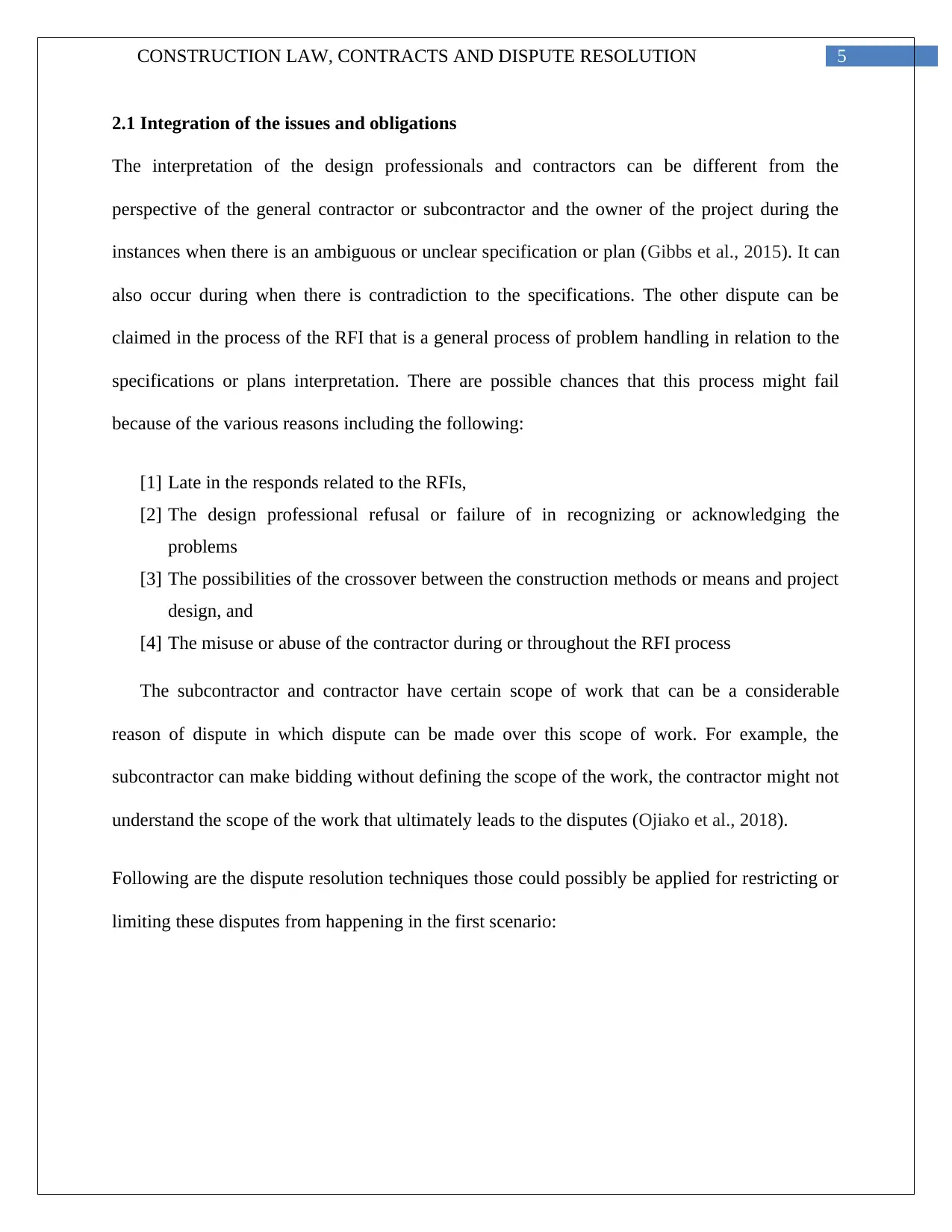
5CONSTRUCTION LAW, CONTRACTS AND DISPUTE RESOLUTION
2.1 Integration of the issues and obligations
The interpretation of the design professionals and contractors can be different from the
perspective of the general contractor or subcontractor and the owner of the project during the
instances when there is an ambiguous or unclear specification or plan (Gibbs et al., 2015). It can
also occur during when there is contradiction to the specifications. The other dispute can be
claimed in the process of the RFI that is a general process of problem handling in relation to the
specifications or plans interpretation. There are possible chances that this process might fail
because of the various reasons including the following:
[1] Late in the responds related to the RFIs,
[2] The design professional refusal or failure of in recognizing or acknowledging the
problems
[3] The possibilities of the crossover between the construction methods or means and project
design, and
[4] The misuse or abuse of the contractor during or throughout the RFI process
The subcontractor and contractor have certain scope of work that can be a considerable
reason of dispute in which dispute can be made over this scope of work. For example, the
subcontractor can make bidding without defining the scope of the work, the contractor might not
understand the scope of the work that ultimately leads to the disputes (Ojiako et al., 2018).
Following are the dispute resolution techniques those could possibly be applied for restricting or
limiting these disputes from happening in the first scenario:
2.1 Integration of the issues and obligations
The interpretation of the design professionals and contractors can be different from the
perspective of the general contractor or subcontractor and the owner of the project during the
instances when there is an ambiguous or unclear specification or plan (Gibbs et al., 2015). It can
also occur during when there is contradiction to the specifications. The other dispute can be
claimed in the process of the RFI that is a general process of problem handling in relation to the
specifications or plans interpretation. There are possible chances that this process might fail
because of the various reasons including the following:
[1] Late in the responds related to the RFIs,
[2] The design professional refusal or failure of in recognizing or acknowledging the
problems
[3] The possibilities of the crossover between the construction methods or means and project
design, and
[4] The misuse or abuse of the contractor during or throughout the RFI process
The subcontractor and contractor have certain scope of work that can be a considerable
reason of dispute in which dispute can be made over this scope of work. For example, the
subcontractor can make bidding without defining the scope of the work, the contractor might not
understand the scope of the work that ultimately leads to the disputes (Ojiako et al., 2018).
Following are the dispute resolution techniques those could possibly be applied for restricting or
limiting these disputes from happening in the first scenario:
⊘ This is a preview!⊘
Do you want full access?
Subscribe today to unlock all pages.

Trusted by 1+ million students worldwide
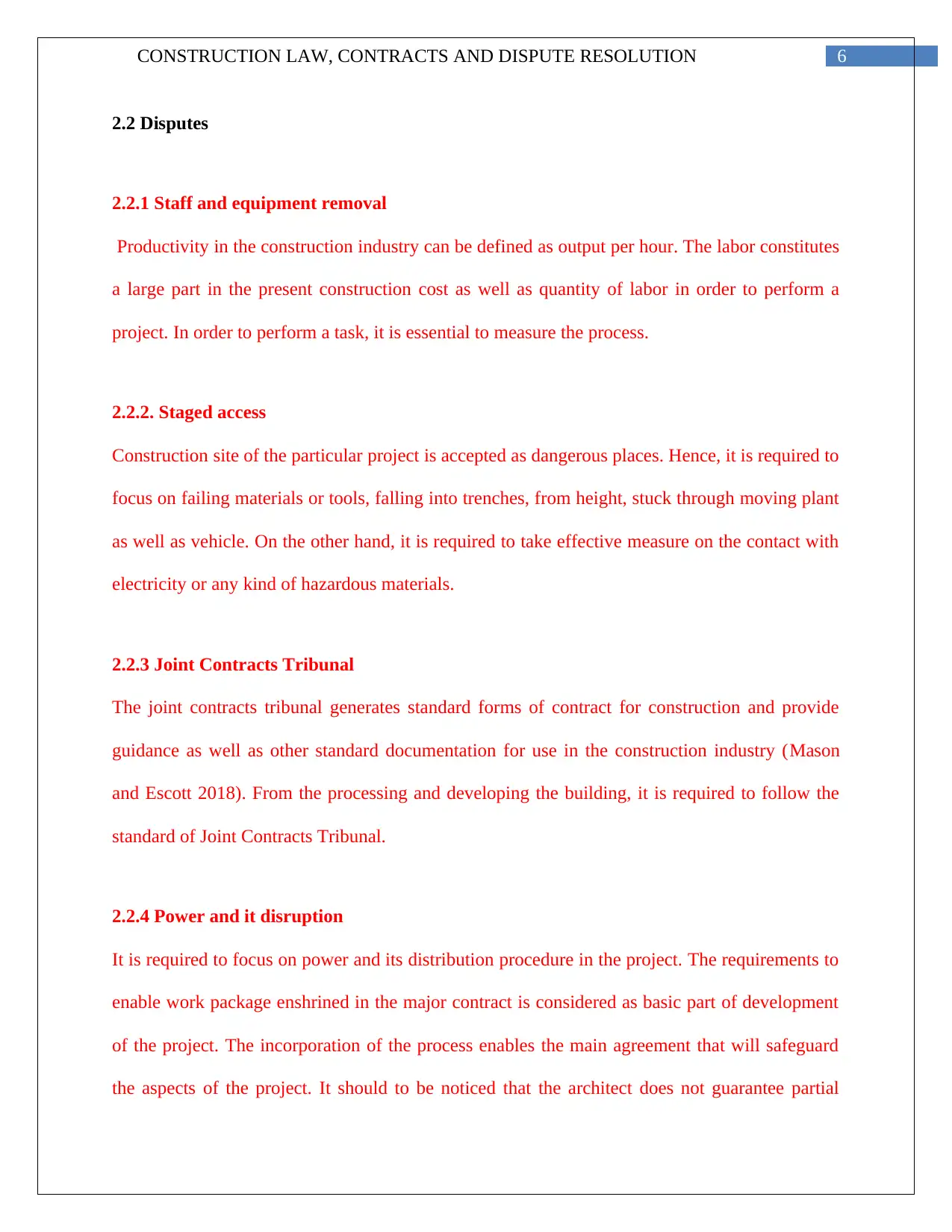
6CONSTRUCTION LAW, CONTRACTS AND DISPUTE RESOLUTION
2.2 Disputes
2.2.1 Staff and equipment removal
Productivity in the construction industry can be defined as output per hour. The labor constitutes
a large part in the present construction cost as well as quantity of labor in order to perform a
project. In order to perform a task, it is essential to measure the process.
2.2.2. Staged access
Construction site of the particular project is accepted as dangerous places. Hence, it is required to
focus on failing materials or tools, falling into trenches, from height, stuck through moving plant
as well as vehicle. On the other hand, it is required to take effective measure on the contact with
electricity or any kind of hazardous materials.
2.2.3 Joint Contracts Tribunal
The joint contracts tribunal generates standard forms of contract for construction and provide
guidance as well as other standard documentation for use in the construction industry (Mason
and Escott 2018). From the processing and developing the building, it is required to follow the
standard of Joint Contracts Tribunal.
2.2.4 Power and it disruption
It is required to focus on power and its distribution procedure in the project. The requirements to
enable work package enshrined in the major contract is considered as basic part of development
of the project. The incorporation of the process enables the main agreement that will safeguard
the aspects of the project. It should to be noticed that the architect does not guarantee partial
2.2 Disputes
2.2.1 Staff and equipment removal
Productivity in the construction industry can be defined as output per hour. The labor constitutes
a large part in the present construction cost as well as quantity of labor in order to perform a
project. In order to perform a task, it is essential to measure the process.
2.2.2. Staged access
Construction site of the particular project is accepted as dangerous places. Hence, it is required to
focus on failing materials or tools, falling into trenches, from height, stuck through moving plant
as well as vehicle. On the other hand, it is required to take effective measure on the contact with
electricity or any kind of hazardous materials.
2.2.3 Joint Contracts Tribunal
The joint contracts tribunal generates standard forms of contract for construction and provide
guidance as well as other standard documentation for use in the construction industry (Mason
and Escott 2018). From the processing and developing the building, it is required to follow the
standard of Joint Contracts Tribunal.
2.2.4 Power and it disruption
It is required to focus on power and its distribution procedure in the project. The requirements to
enable work package enshrined in the major contract is considered as basic part of development
of the project. The incorporation of the process enables the main agreement that will safeguard
the aspects of the project. It should to be noticed that the architect does not guarantee partial
Paraphrase This Document
Need a fresh take? Get an instant paraphrase of this document with our AI Paraphraser
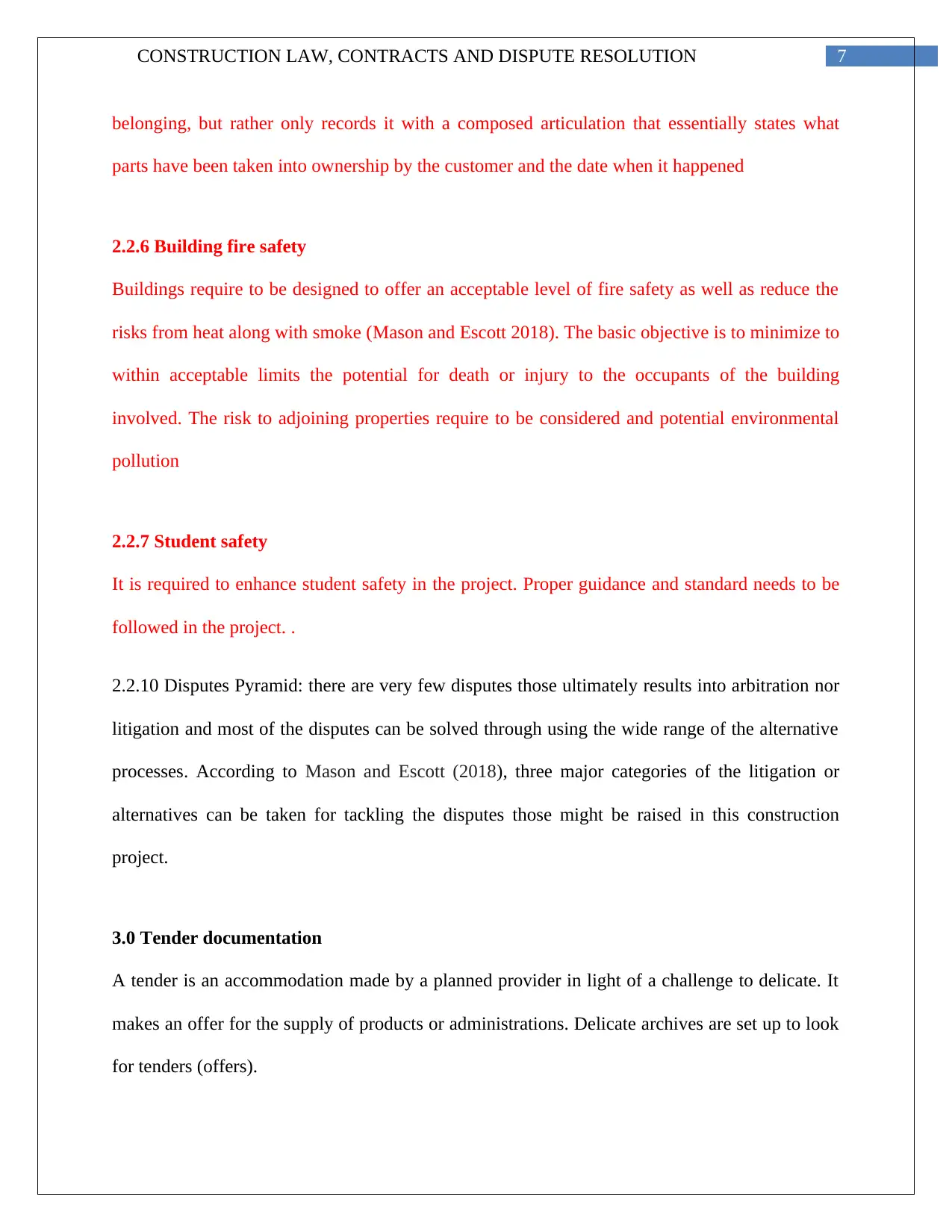
7CONSTRUCTION LAW, CONTRACTS AND DISPUTE RESOLUTION
belonging, but rather only records it with a composed articulation that essentially states what
parts have been taken into ownership by the customer and the date when it happened
2.2.6 Building fire safety
Buildings require to be designed to offer an acceptable level of fire safety as well as reduce the
risks from heat along with smoke (Mason and Escott 2018). The basic objective is to minimize to
within acceptable limits the potential for death or injury to the occupants of the building
involved. The risk to adjoining properties require to be considered and potential environmental
pollution
2.2.7 Student safety
It is required to enhance student safety in the project. Proper guidance and standard needs to be
followed in the project. .
2.2.10 Disputes Pyramid: there are very few disputes those ultimately results into arbitration nor
litigation and most of the disputes can be solved through using the wide range of the alternative
processes. According to Mason and Escott (2018), three major categories of the litigation or
alternatives can be taken for tackling the disputes those might be raised in this construction
project.
3.0 Tender documentation
A tender is an accommodation made by a planned provider in light of a challenge to delicate. It
makes an offer for the supply of products or administrations. Delicate archives are set up to look
for tenders (offers).
belonging, but rather only records it with a composed articulation that essentially states what
parts have been taken into ownership by the customer and the date when it happened
2.2.6 Building fire safety
Buildings require to be designed to offer an acceptable level of fire safety as well as reduce the
risks from heat along with smoke (Mason and Escott 2018). The basic objective is to minimize to
within acceptable limits the potential for death or injury to the occupants of the building
involved. The risk to adjoining properties require to be considered and potential environmental
pollution
2.2.7 Student safety
It is required to enhance student safety in the project. Proper guidance and standard needs to be
followed in the project. .
2.2.10 Disputes Pyramid: there are very few disputes those ultimately results into arbitration nor
litigation and most of the disputes can be solved through using the wide range of the alternative
processes. According to Mason and Escott (2018), three major categories of the litigation or
alternatives can be taken for tackling the disputes those might be raised in this construction
project.
3.0 Tender documentation
A tender is an accommodation made by a planned provider in light of a challenge to delicate. It
makes an offer for the supply of products or administrations. Delicate archives are set up to look
for tenders (offers).
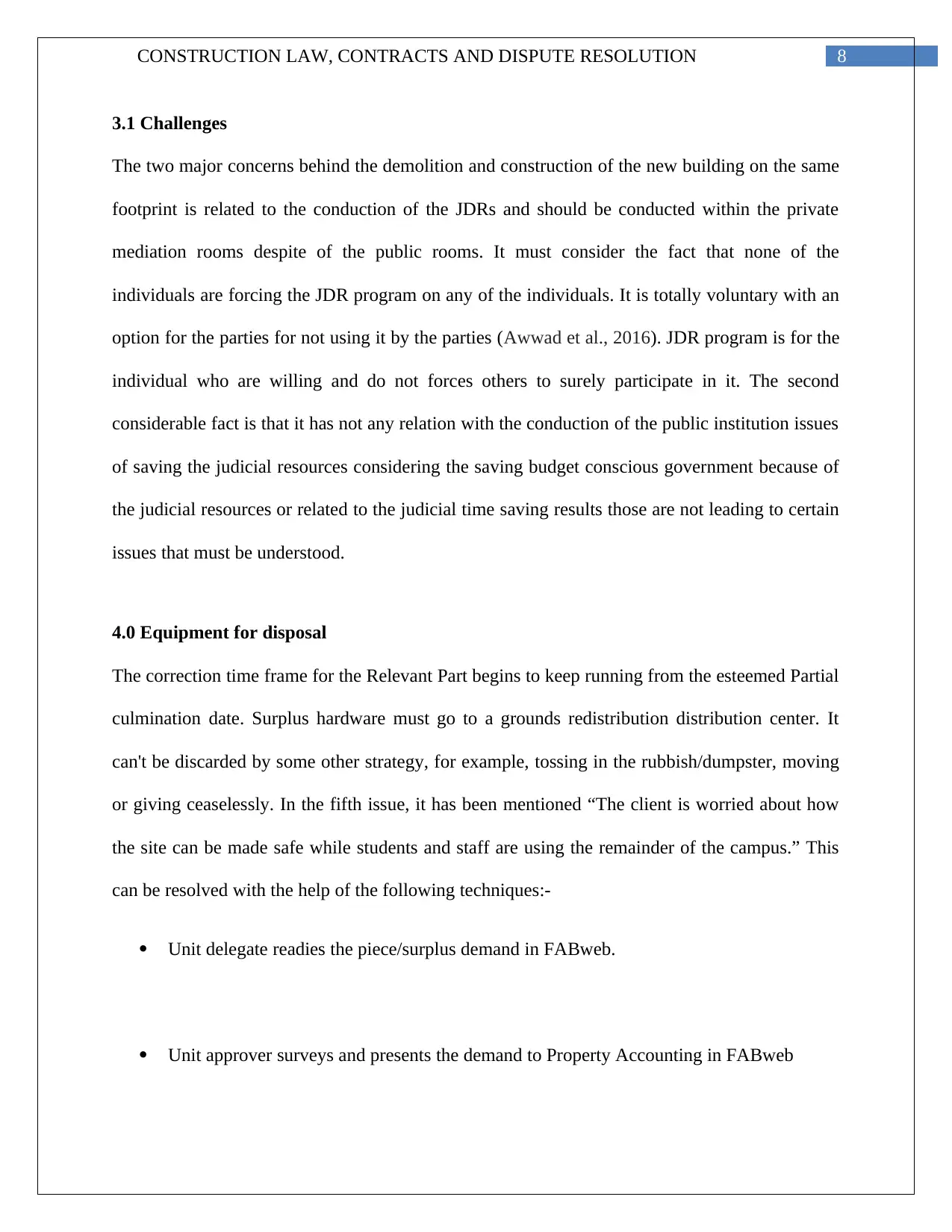
8CONSTRUCTION LAW, CONTRACTS AND DISPUTE RESOLUTION
3.1 Challenges
The two major concerns behind the demolition and construction of the new building on the same
footprint is related to the conduction of the JDRs and should be conducted within the private
mediation rooms despite of the public rooms. It must consider the fact that none of the
individuals are forcing the JDR program on any of the individuals. It is totally voluntary with an
option for the parties for not using it by the parties (Awwad et al., 2016). JDR program is for the
individual who are willing and do not forces others to surely participate in it. The second
considerable fact is that it has not any relation with the conduction of the public institution issues
of saving the judicial resources considering the saving budget conscious government because of
the judicial resources or related to the judicial time saving results those are not leading to certain
issues that must be understood.
4.0 Equipment for disposal
The correction time frame for the Relevant Part begins to keep running from the esteemed Partial
culmination date. Surplus hardware must go to a grounds redistribution distribution center. It
can't be discarded by some other strategy, for example, tossing in the rubbish/dumpster, moving
or giving ceaselessly. In the fifth issue, it has been mentioned “The client is worried about how
the site can be made safe while students and staff are using the remainder of the campus.” This
can be resolved with the help of the following techniques:-
Unit delegate readies the piece/surplus demand in FABweb.
Unit approver surveys and presents the demand to Property Accounting in FABweb
3.1 Challenges
The two major concerns behind the demolition and construction of the new building on the same
footprint is related to the conduction of the JDRs and should be conducted within the private
mediation rooms despite of the public rooms. It must consider the fact that none of the
individuals are forcing the JDR program on any of the individuals. It is totally voluntary with an
option for the parties for not using it by the parties (Awwad et al., 2016). JDR program is for the
individual who are willing and do not forces others to surely participate in it. The second
considerable fact is that it has not any relation with the conduction of the public institution issues
of saving the judicial resources considering the saving budget conscious government because of
the judicial resources or related to the judicial time saving results those are not leading to certain
issues that must be understood.
4.0 Equipment for disposal
The correction time frame for the Relevant Part begins to keep running from the esteemed Partial
culmination date. Surplus hardware must go to a grounds redistribution distribution center. It
can't be discarded by some other strategy, for example, tossing in the rubbish/dumpster, moving
or giving ceaselessly. In the fifth issue, it has been mentioned “The client is worried about how
the site can be made safe while students and staff are using the remainder of the campus.” This
can be resolved with the help of the following techniques:-
Unit delegate readies the piece/surplus demand in FABweb.
Unit approver surveys and presents the demand to Property Accounting in FABweb
⊘ This is a preview!⊘
Do you want full access?
Subscribe today to unlock all pages.

Trusted by 1+ million students worldwide
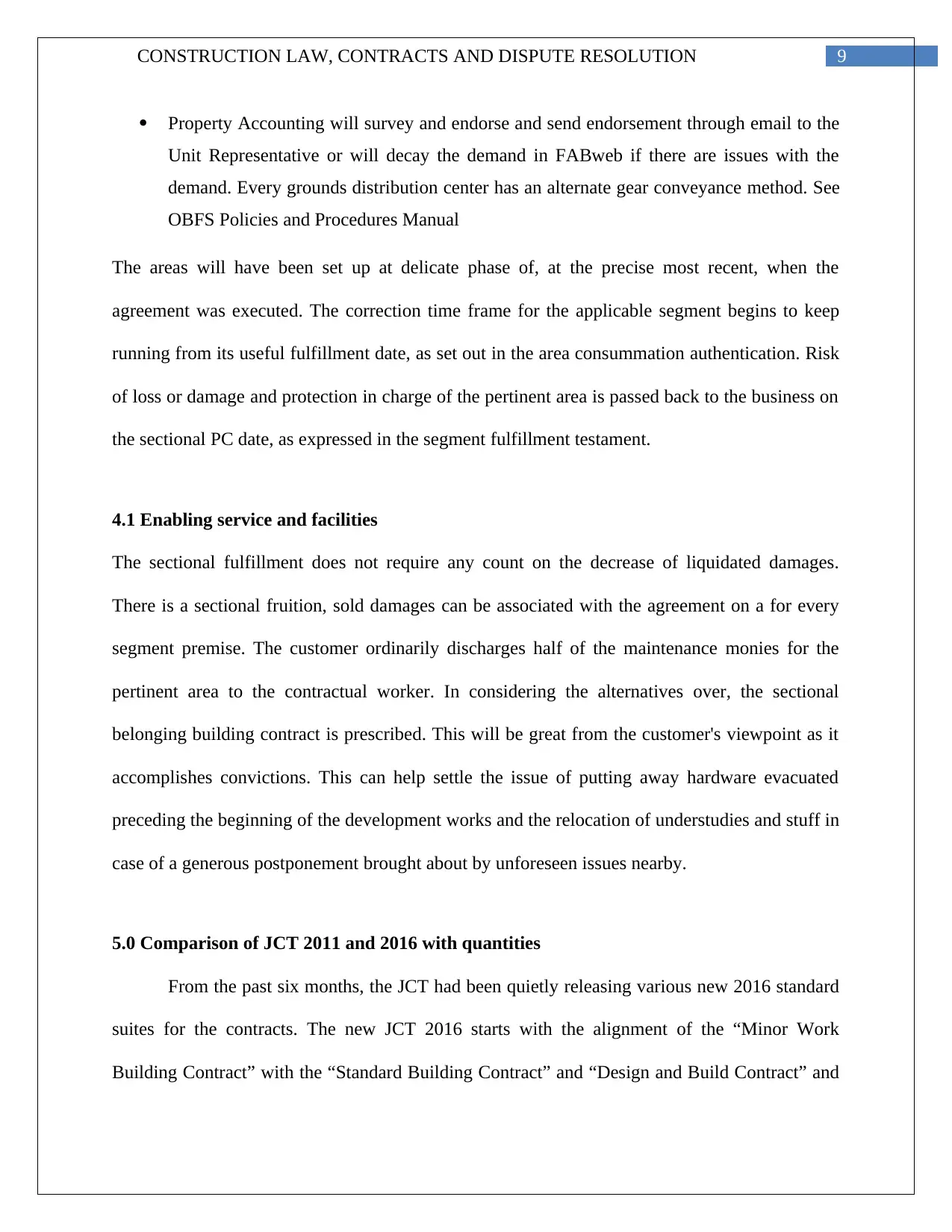
9CONSTRUCTION LAW, CONTRACTS AND DISPUTE RESOLUTION
Property Accounting will survey and endorse and send endorsement through email to the
Unit Representative or will decay the demand in FABweb if there are issues with the
demand. Every grounds distribution center has an alternate gear conveyance method. See
OBFS Policies and Procedures Manual
The areas will have been set up at delicate phase of, at the precise most recent, when the
agreement was executed. The correction time frame for the applicable segment begins to keep
running from its useful fulfillment date, as set out in the area consummation authentication. Risk
of loss or damage and protection in charge of the pertinent area is passed back to the business on
the sectional PC date, as expressed in the segment fulfillment testament.
4.1 Enabling service and facilities
The sectional fulfillment does not require any count on the decrease of liquidated damages.
There is a sectional fruition, sold damages can be associated with the agreement on a for every
segment premise. The customer ordinarily discharges half of the maintenance monies for the
pertinent area to the contractual worker. In considering the alternatives over, the sectional
belonging building contract is prescribed. This will be great from the customer's viewpoint as it
accomplishes convictions. This can help settle the issue of putting away hardware evacuated
preceding the beginning of the development works and the relocation of understudies and stuff in
case of a generous postponement brought about by unforeseen issues nearby.
5.0 Comparison of JCT 2011 and 2016 with quantities
From the past six months, the JCT had been quietly releasing various new 2016 standard
suites for the contracts. The new JCT 2016 starts with the alignment of the “Minor Work
Building Contract” with the “Standard Building Contract” and “Design and Build Contract” and
Property Accounting will survey and endorse and send endorsement through email to the
Unit Representative or will decay the demand in FABweb if there are issues with the
demand. Every grounds distribution center has an alternate gear conveyance method. See
OBFS Policies and Procedures Manual
The areas will have been set up at delicate phase of, at the precise most recent, when the
agreement was executed. The correction time frame for the applicable segment begins to keep
running from its useful fulfillment date, as set out in the area consummation authentication. Risk
of loss or damage and protection in charge of the pertinent area is passed back to the business on
the sectional PC date, as expressed in the segment fulfillment testament.
4.1 Enabling service and facilities
The sectional fulfillment does not require any count on the decrease of liquidated damages.
There is a sectional fruition, sold damages can be associated with the agreement on a for every
segment premise. The customer ordinarily discharges half of the maintenance monies for the
pertinent area to the contractual worker. In considering the alternatives over, the sectional
belonging building contract is prescribed. This will be great from the customer's viewpoint as it
accomplishes convictions. This can help settle the issue of putting away hardware evacuated
preceding the beginning of the development works and the relocation of understudies and stuff in
case of a generous postponement brought about by unforeseen issues nearby.
5.0 Comparison of JCT 2011 and 2016 with quantities
From the past six months, the JCT had been quietly releasing various new 2016 standard
suites for the contracts. The new JCT 2016 starts with the alignment of the “Minor Work
Building Contract” with the “Standard Building Contract” and “Design and Build Contract” and
Paraphrase This Document
Need a fresh take? Get an instant paraphrase of this document with our AI Paraphraser
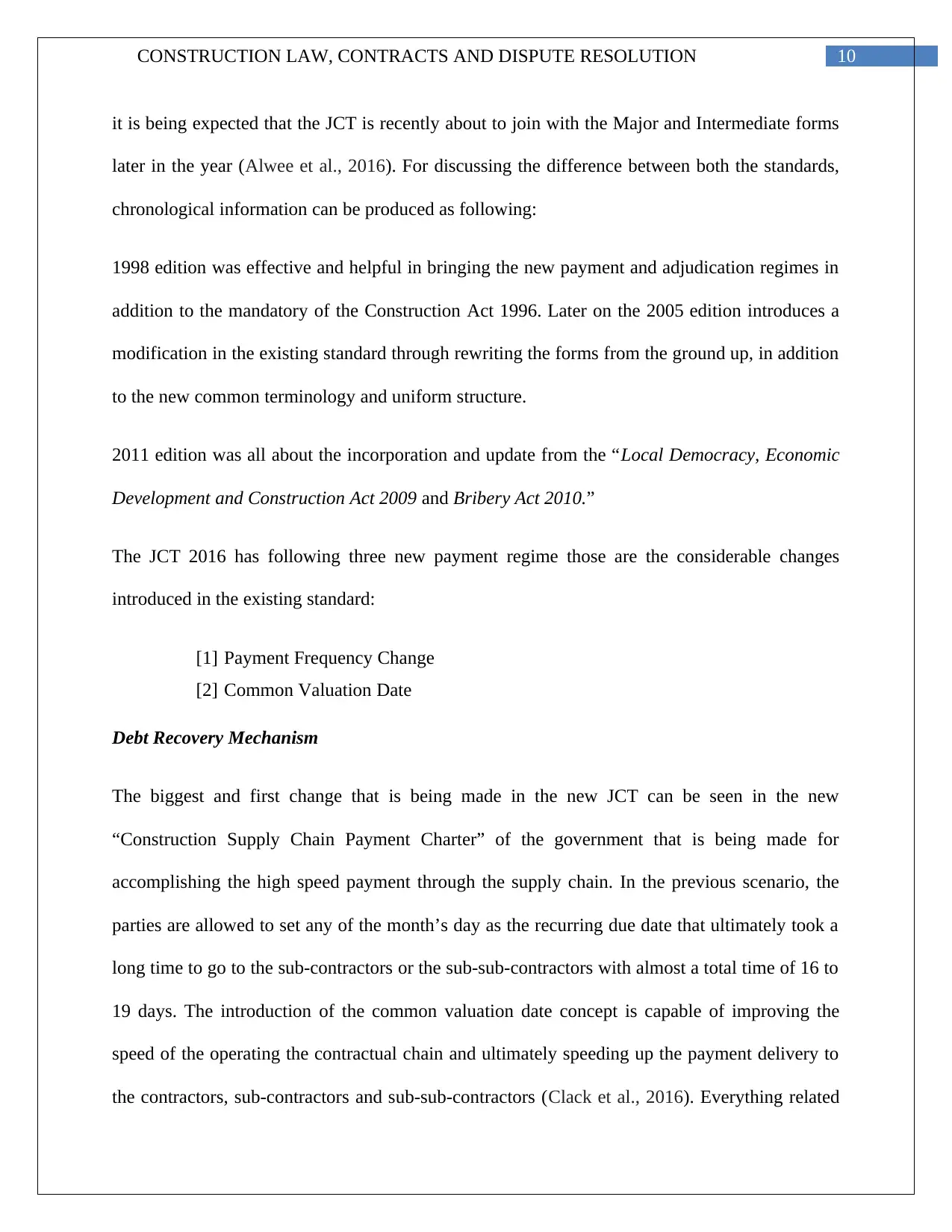
10CONSTRUCTION LAW, CONTRACTS AND DISPUTE RESOLUTION
it is being expected that the JCT is recently about to join with the Major and Intermediate forms
later in the year (Alwee et al., 2016). For discussing the difference between both the standards,
chronological information can be produced as following:
1998 edition was effective and helpful in bringing the new payment and adjudication regimes in
addition to the mandatory of the Construction Act 1996. Later on the 2005 edition introduces a
modification in the existing standard through rewriting the forms from the ground up, in addition
to the new common terminology and uniform structure.
2011 edition was all about the incorporation and update from the “Local Democracy, Economic
Development and Construction Act 2009 and Bribery Act 2010.”
The JCT 2016 has following three new payment regime those are the considerable changes
introduced in the existing standard:
[1] Payment Frequency Change
[2] Common Valuation Date
Debt Recovery Mechanism
The biggest and first change that is being made in the new JCT can be seen in the new
“Construction Supply Chain Payment Charter” of the government that is being made for
accomplishing the high speed payment through the supply chain. In the previous scenario, the
parties are allowed to set any of the month’s day as the recurring due date that ultimately took a
long time to go to the sub-contractors or the sub-sub-contractors with almost a total time of 16 to
19 days. The introduction of the common valuation date concept is capable of improving the
speed of the operating the contractual chain and ultimately speeding up the payment delivery to
the contractors, sub-contractors and sub-sub-contractors (Clack et al., 2016). Everything related
it is being expected that the JCT is recently about to join with the Major and Intermediate forms
later in the year (Alwee et al., 2016). For discussing the difference between both the standards,
chronological information can be produced as following:
1998 edition was effective and helpful in bringing the new payment and adjudication regimes in
addition to the mandatory of the Construction Act 1996. Later on the 2005 edition introduces a
modification in the existing standard through rewriting the forms from the ground up, in addition
to the new common terminology and uniform structure.
2011 edition was all about the incorporation and update from the “Local Democracy, Economic
Development and Construction Act 2009 and Bribery Act 2010.”
The JCT 2016 has following three new payment regime those are the considerable changes
introduced in the existing standard:
[1] Payment Frequency Change
[2] Common Valuation Date
Debt Recovery Mechanism
The biggest and first change that is being made in the new JCT can be seen in the new
“Construction Supply Chain Payment Charter” of the government that is being made for
accomplishing the high speed payment through the supply chain. In the previous scenario, the
parties are allowed to set any of the month’s day as the recurring due date that ultimately took a
long time to go to the sub-contractors or the sub-sub-contractors with almost a total time of 16 to
19 days. The introduction of the common valuation date concept is capable of improving the
speed of the operating the contractual chain and ultimately speeding up the payment delivery to
the contractors, sub-contractors and sub-sub-contractors (Clack et al., 2016). Everything related
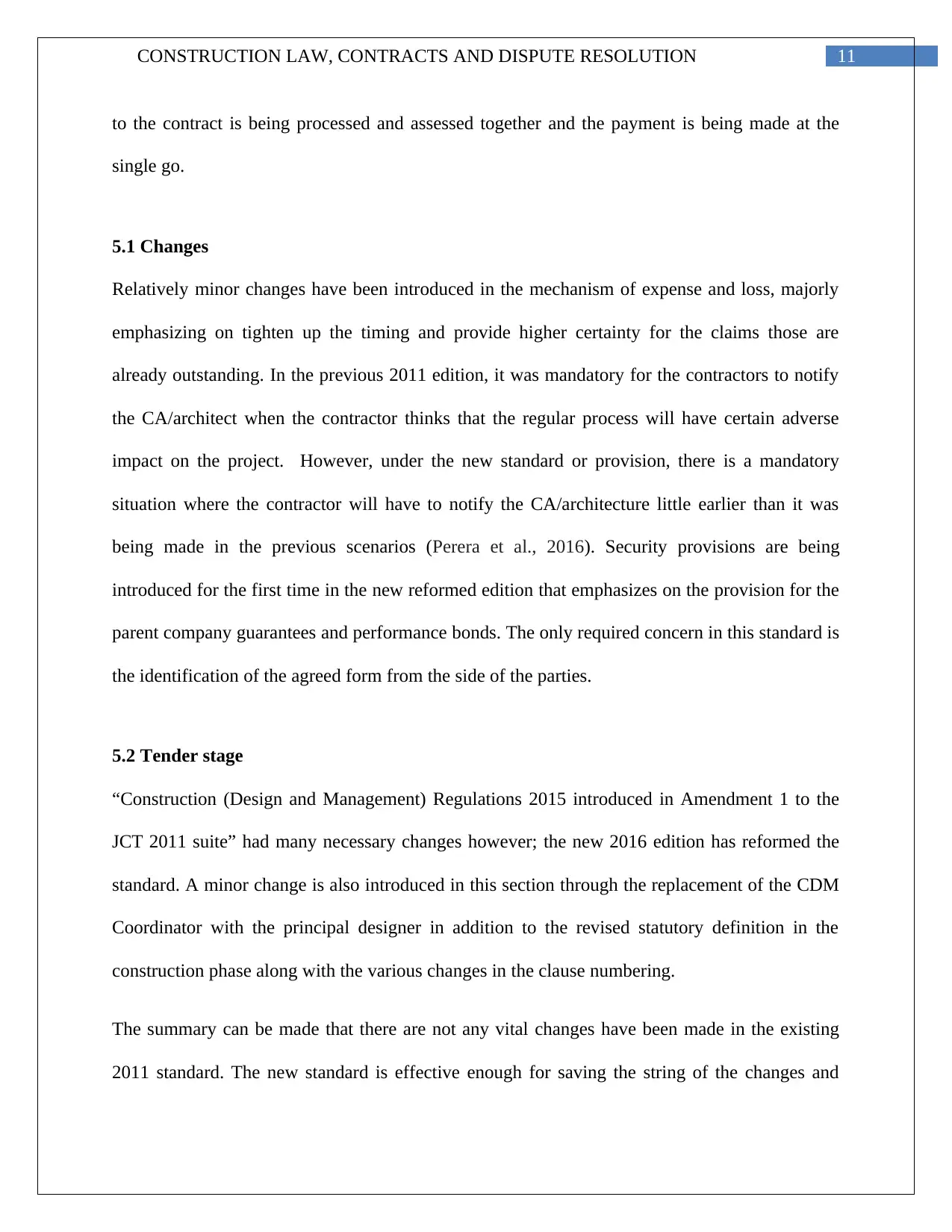
11CONSTRUCTION LAW, CONTRACTS AND DISPUTE RESOLUTION
to the contract is being processed and assessed together and the payment is being made at the
single go.
5.1 Changes
Relatively minor changes have been introduced in the mechanism of expense and loss, majorly
emphasizing on tighten up the timing and provide higher certainty for the claims those are
already outstanding. In the previous 2011 edition, it was mandatory for the contractors to notify
the CA/architect when the contractor thinks that the regular process will have certain adverse
impact on the project. However, under the new standard or provision, there is a mandatory
situation where the contractor will have to notify the CA/architecture little earlier than it was
being made in the previous scenarios (Perera et al., 2016). Security provisions are being
introduced for the first time in the new reformed edition that emphasizes on the provision for the
parent company guarantees and performance bonds. The only required concern in this standard is
the identification of the agreed form from the side of the parties.
5.2 Tender stage
“Construction (Design and Management) Regulations 2015 introduced in Amendment 1 to the
JCT 2011 suite” had many necessary changes however; the new 2016 edition has reformed the
standard. A minor change is also introduced in this section through the replacement of the CDM
Coordinator with the principal designer in addition to the revised statutory definition in the
construction phase along with the various changes in the clause numbering.
The summary can be made that there are not any vital changes have been made in the existing
2011 standard. The new standard is effective enough for saving the string of the changes and
to the contract is being processed and assessed together and the payment is being made at the
single go.
5.1 Changes
Relatively minor changes have been introduced in the mechanism of expense and loss, majorly
emphasizing on tighten up the timing and provide higher certainty for the claims those are
already outstanding. In the previous 2011 edition, it was mandatory for the contractors to notify
the CA/architect when the contractor thinks that the regular process will have certain adverse
impact on the project. However, under the new standard or provision, there is a mandatory
situation where the contractor will have to notify the CA/architecture little earlier than it was
being made in the previous scenarios (Perera et al., 2016). Security provisions are being
introduced for the first time in the new reformed edition that emphasizes on the provision for the
parent company guarantees and performance bonds. The only required concern in this standard is
the identification of the agreed form from the side of the parties.
5.2 Tender stage
“Construction (Design and Management) Regulations 2015 introduced in Amendment 1 to the
JCT 2011 suite” had many necessary changes however; the new 2016 edition has reformed the
standard. A minor change is also introduced in this section through the replacement of the CDM
Coordinator with the principal designer in addition to the revised statutory definition in the
construction phase along with the various changes in the clause numbering.
The summary can be made that there are not any vital changes have been made in the existing
2011 standard. The new standard is effective enough for saving the string of the changes and
⊘ This is a preview!⊘
Do you want full access?
Subscribe today to unlock all pages.

Trusted by 1+ million students worldwide
1 out of 20
Related Documents
Your All-in-One AI-Powered Toolkit for Academic Success.
+13062052269
info@desklib.com
Available 24*7 on WhatsApp / Email
![[object Object]](/_next/static/media/star-bottom.7253800d.svg)
Unlock your academic potential
Copyright © 2020–2025 A2Z Services. All Rights Reserved. Developed and managed by ZUCOL.





